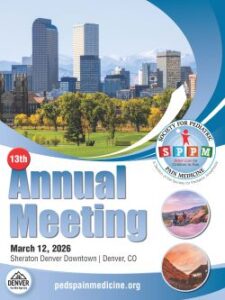{“questions”:{“71ld7”:{“id”:”71ld7″,”mediaType”:”image”,”answerType”:”text”,”imageCredit”:””,”image”:””,”imageId”:””,”video”:””,”imagePlaceholder”:””,”imagePlaceholderId”:””,”title”:”A 15-year-old previously healthy female was referred by dermatology for widespread itching refractory to multiple dermatologic treatments. Careful history suggested the itching sensations may have a neuropathic quality similar to paresthesias. As a pain physician comfortable with neuropathic medications, the referring physician would like you to consider a trial of gabapentin related to a possible small fiber neuropathy. On follow up, the patient reports >50% improvement in itching with low doses of gabapentin. As this is the first treatment to reduce symptoms, her mother would like to know why it helped when other treatments failed and whether she has a small fiber neuropathy.
Question of the Month – March 2024
{“questions”:{“wughy”:{“id”:”wughy”,”mediaType”:”image”,”answerType”:”text”,”imageCredit”:””,”image”:””,”imageId”:””,”video”:””,”imagePlaceholder”:””,”imagePlaceholderId”:””,”title”:”A 14-month-old male with medical history significant for sleep disordered breathing presents to the OR for circumcision. Previous analgesic plan included a caudal epidural block, however on physical exam there is concern for a sacral dimple. Which of the following alternate options would potentially convey the greatest benefit of achieving maximal analgesia?”,”desc”:””,”hint”:””,”answers”:{“qczuj”:{“id”:”qczuj”,”image”:””,”imageId”:””,”title”:”A. acetaminophen and ketorolac”},”qu23x”:{“id”:”qu23x”,”image”:””,”imageId”:””,”title”:”B. pudendal nerve block”,”isCorrect”:”1″},”v11h4″:{“id”:”v11h4″,”image”:””,”imageId”:””,”title”:”C. dorsal penile block”},”c4i3w”:{“id”:”c4i3w”,”image”:””,”imageId”:””,”title”:”D. ring block of the penis”}}}},”results”:{“wfejf”:{“id”:”wfejf”,”title”:””,”image”:””,”imageId”:””,”min”:”0″,”max”:”1″,”desc”:””,”redirect_url”:”https:\/\/pedspainmedicine.org\/wp-content\/uploads\/2024\/03\/SPPM-QOM-March-2024.pdf”}}}
Question of the Month – February 2024
{“questions”:{“rre6v”:{“id”:”rre6v”,”mediaType”:”image”,”answerType”:”text”,”imageCredit”:””,”image”:””,”imageId”:””,”video”:””,”imagePlaceholder”:””,”imagePlaceholderId”:””,”title”:”When discussing patients with Ehlers Danlos Syndrome (EDS), which of the following statements is FALSE?”,”desc”:””,”hint”:””,”answers”:{“cvwlg”:{“id”:”cvwlg”,”image”:””,”imageId”:””,”title”:”A. EDS patients have decreased efficacy to local anesthetic medications when local infiltration is performed”},”p8wsv”:{“id”:”p8wsv”,”image”:””,”imageId”:””,”title”:”B. Many patients with EDS also have concurrent chronic pain “},”96vy1”:{“id”:”96vy1″,”image”:””,”imageId”:””,”title”:”C. The response of larger peripheral nerve bundles to local anesthetic medications is similar to the response following local infiltration analgesia”,”isCorrect”:”1″},”rj04o”:{“id”:”rj04o”,”image”:””,”imageId”:””,”title”:”D. EDS is a hereditary disease that results in impaired connective tissue integrity”}}}},”results”:{“sux24”:{“id”:”sux24″,”title”:””,”image”:””,”imageId”:””,”min”:”0″,”max”:”1″,”desc”:””,”redirect_url”:”https:\/\/pedspainmedicine.org\/wp-content\/uploads\/2024\/02\/SPPM-QOM-February-2024.pdf”}}}
Question of the Month – January 2024
{“questions”:{“urvgd”:{“id”:”urvgd”,”mediaType”:”image”,”answerType”:”text”,”imageCredit”:””,”image”:””,”imageId”:””,”video”:””,”imagePlaceholder”:””,”imagePlaceholderId”:””,”title”:”A 17-year-old female cheerleader presents for right shoulder anthroscopy. She has a history of rotator cuff injury with lingering pain for 4 months. Which of the following is not a risk factor for persistent postoperative opioid use (PPOU) in children and adolescents?”,”desc”:””,”hint”:””,”answers”:{“y2ge4”:{“id”:”y2ge4″,”image”:””,”imageId”:””,”title”:”A. Past or current opioid use”},”958h0″:{“id”:”958h0″,”image”:””,”imageId”:””,”title”:”B. Older age”},”lef5t”:{“id”:”lef5t”,”image”:””,”imageId”:””,”title”:”C. Family history of Substance Use Disorder”},”1n2ph”:{“id”:”1n2ph”,”image”:””,”imageId”:””,”title”:”D. Female sex”},”vyln3″:{“id”:”vyln3″,”image”:””,”imageId”:””,”title”:”E. All of the above are risk factors for persistent postoperative opioid use in children and adolescents.”,”isCorrect”:”1″}}}},”results”:{“dcce2”:{“id”:”dcce2″,”title”:””,”image”:””,”imageId”:””,”min”:”0″,”max”:”1″,”desc”:””,”redirect_url”:”https:\/\/pedspainmedicine.org\/wp-content\/uploads\/2024\/01\/SPPM-QOM-January-2024.pdf”}}}
Question of the Month – December 2023
{“questions”:{“0f30e”:{“id”:”0f30e”,”mediaType”:”image”,”answerType”:”text”,”imageCredit”:””,”image”:””,”imageId”:””,”video”:””,”imagePlaceholder”:””,”imagePlaceholderId”:””,”title”:”A 15-year-old, female, softball player presents for left knee ACL reconstruction with autograft, following a knee injury few weeks ago. The patient denies any numbness or weakness in her leg at this time, but active knee movement is limited by pain. Her past medical history and physical exam are otherwise unremarkable. Strength is perceived as 5\/5 in all muscles tested. Sensation was normal in the affected lower extremity. For pain management, left femoral nerve block is done with 0.2% ropivacaine (10 ml) under ultrasound guidance, and femoral catheter left in place, after anesthesia induction, prior to surgical incision. iPACK block is done at the end. GETA is otherwise uneventful and surgical tourniquet time is noted to be 92 minutes. In the recovery room, she is pain-free. She is discharged home with nerve catheter in place infusing 0.15% ropivacaine @8 ml\/hr with instructions for catheter care. She was followed by pain service while catheter is in place, and removal at home on postoperative day 3. Over this time there were no motor deficits reported. On routine post-surgical follow up 2 weeks after surgery in orthopedic clinic, she complains of persistent numbness in medial aspect of knee to foot. On exam, she also has weakness 3\/5 with knee extension and has been unable to participate in physical therapy. The orthopedic surgeon refers the patient to the anesthesiologist who performed the block for further assessment. After a thorough exam and discussion, referral to neurology is placed. Electromyography\/nerve conduction studies are conducted a week later which reveal neurapraxia.
- « Previous Page
- 1
- …
- 3
- 4
- 5
- 6
- 7
- …
- 11
- Next Page »
 SPPM 13th Annual Meeting
SPPM 13th Annual Meeting